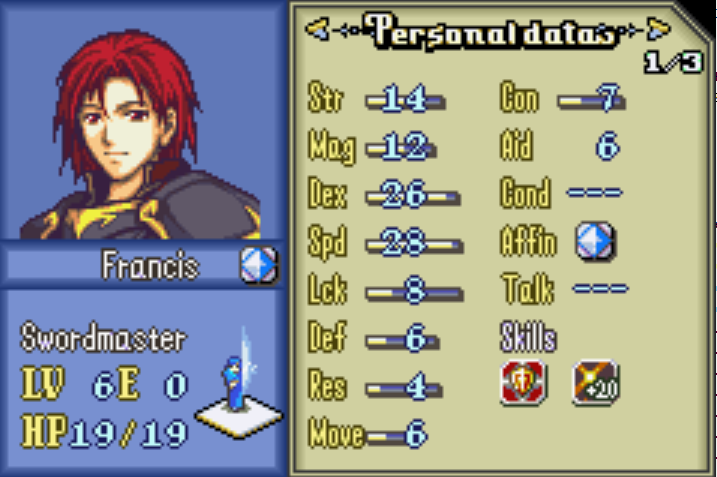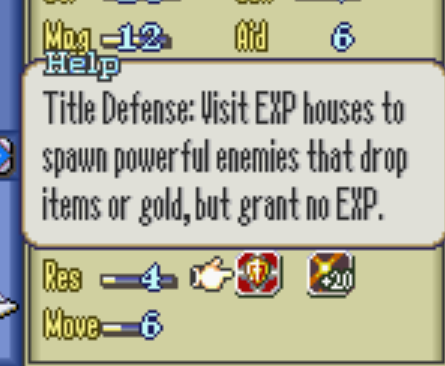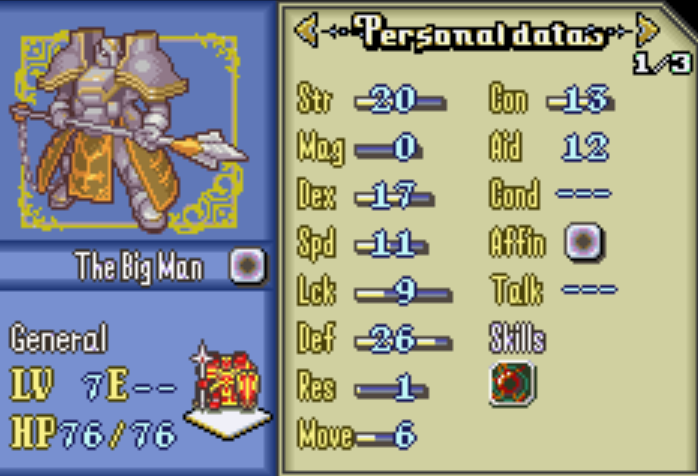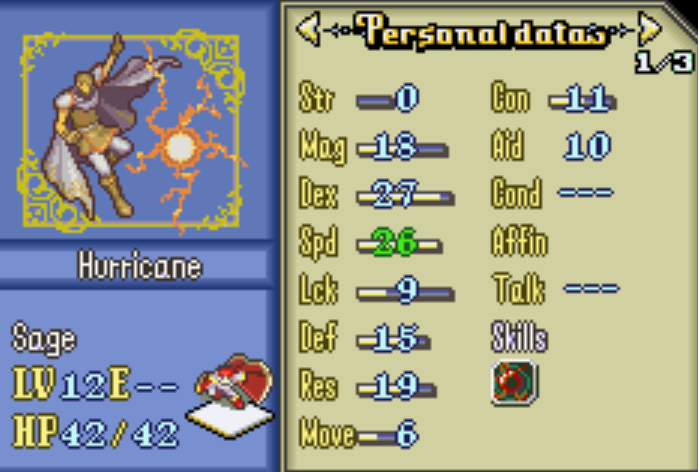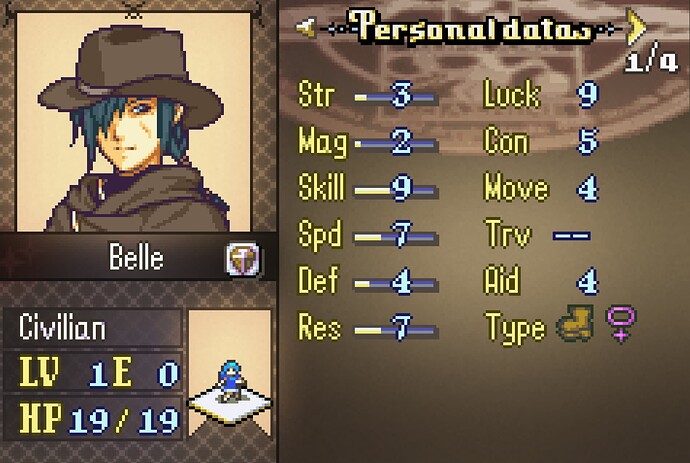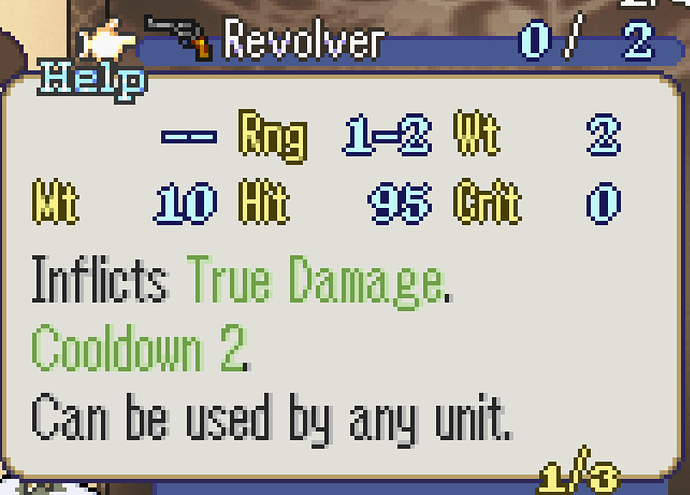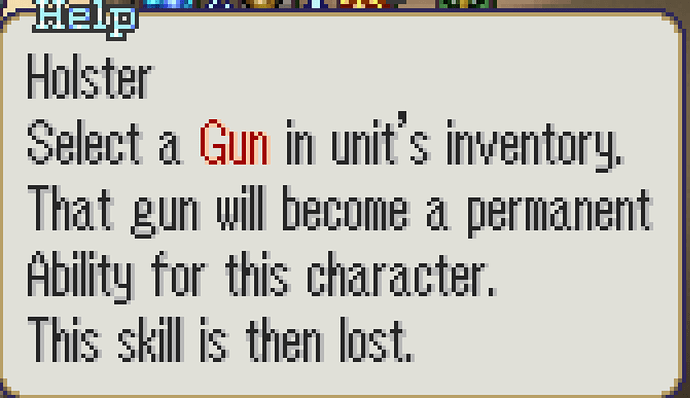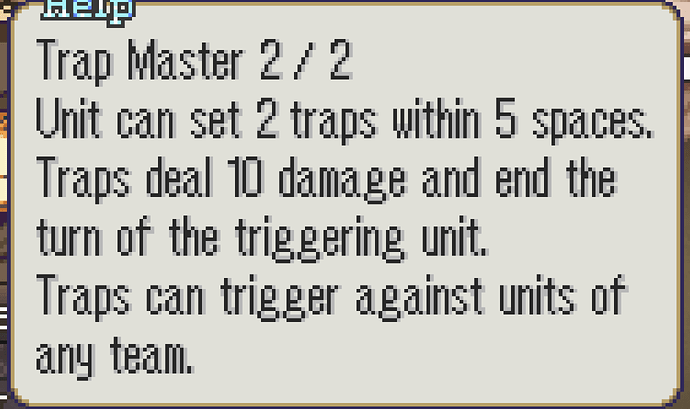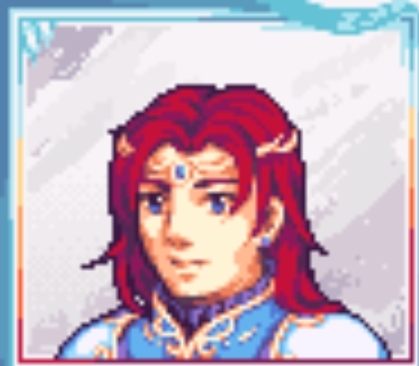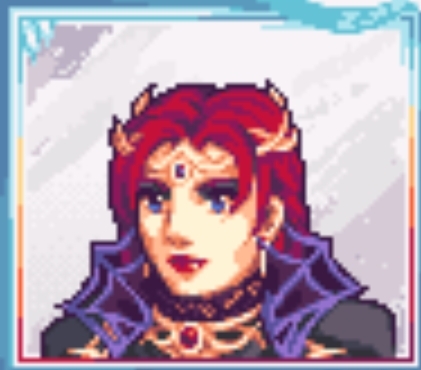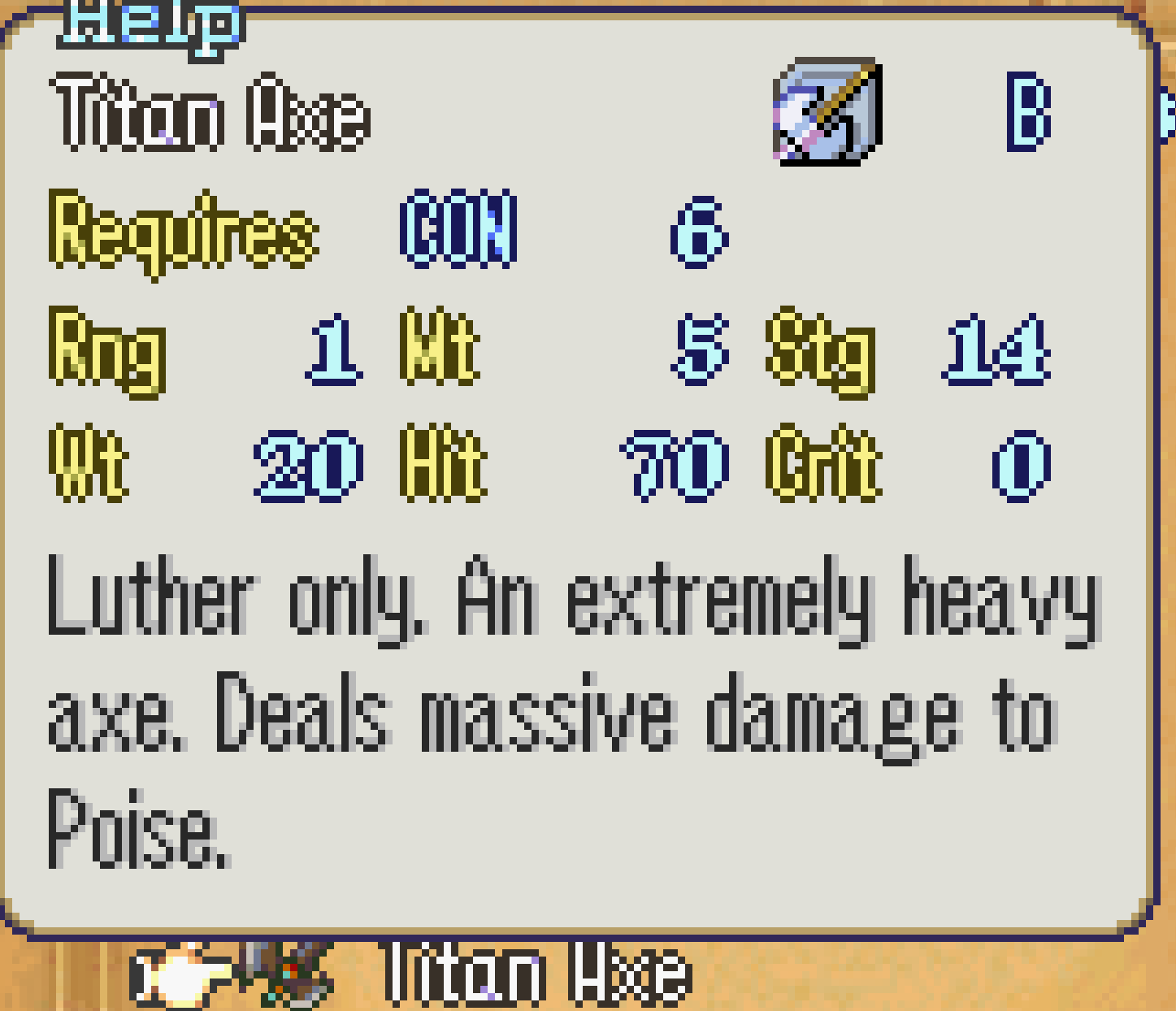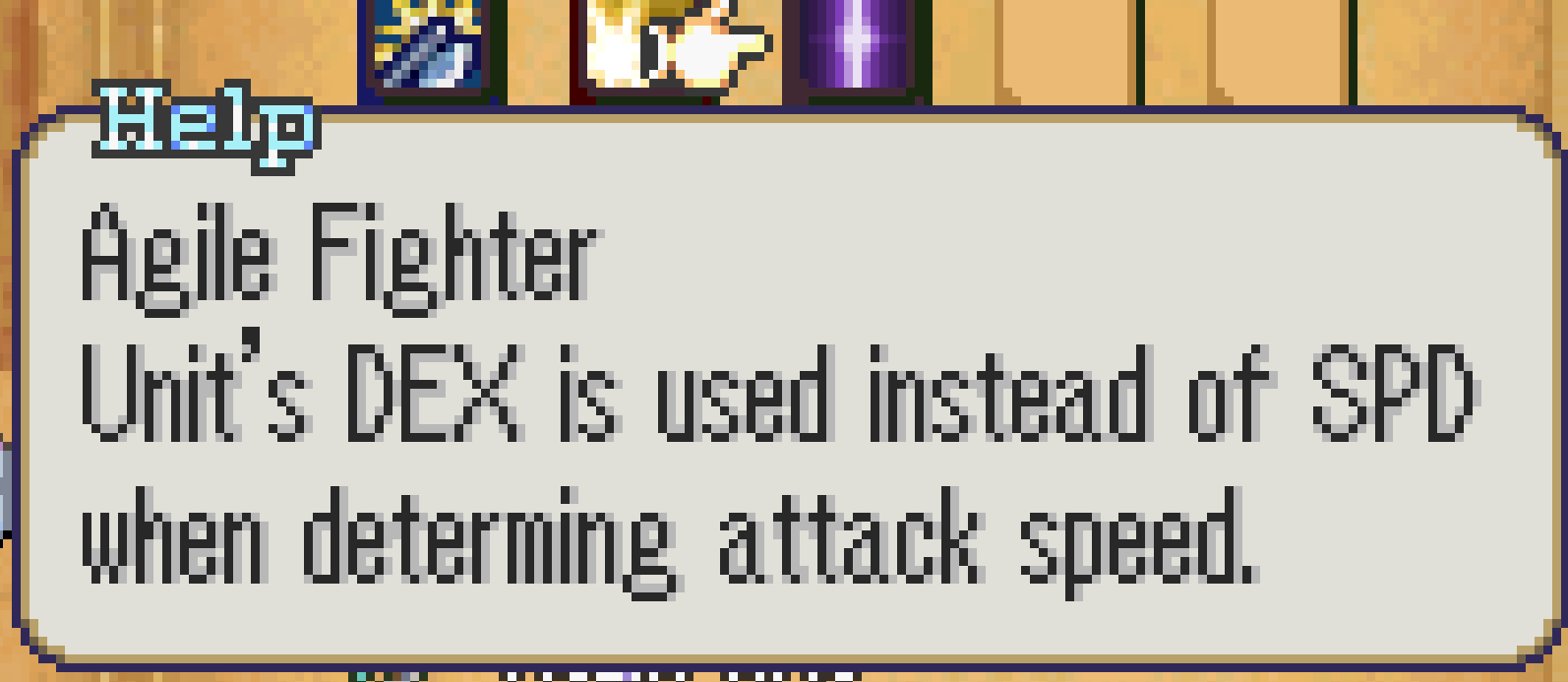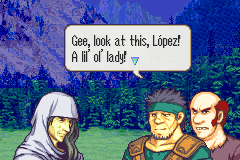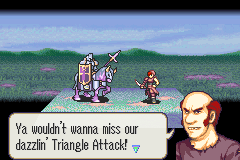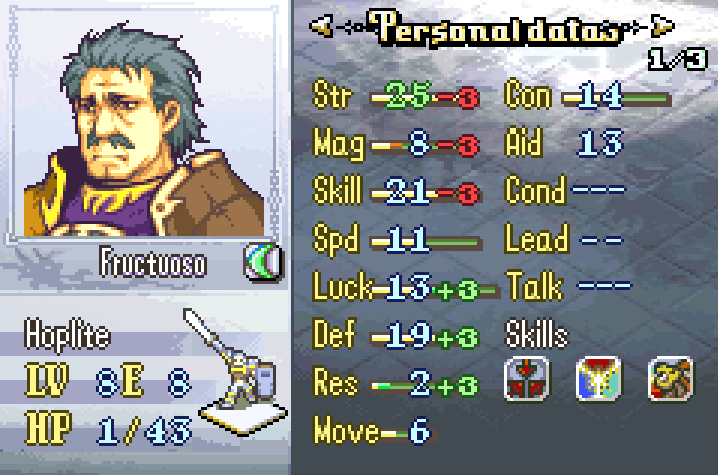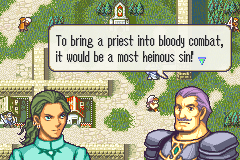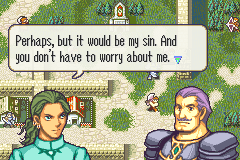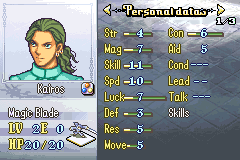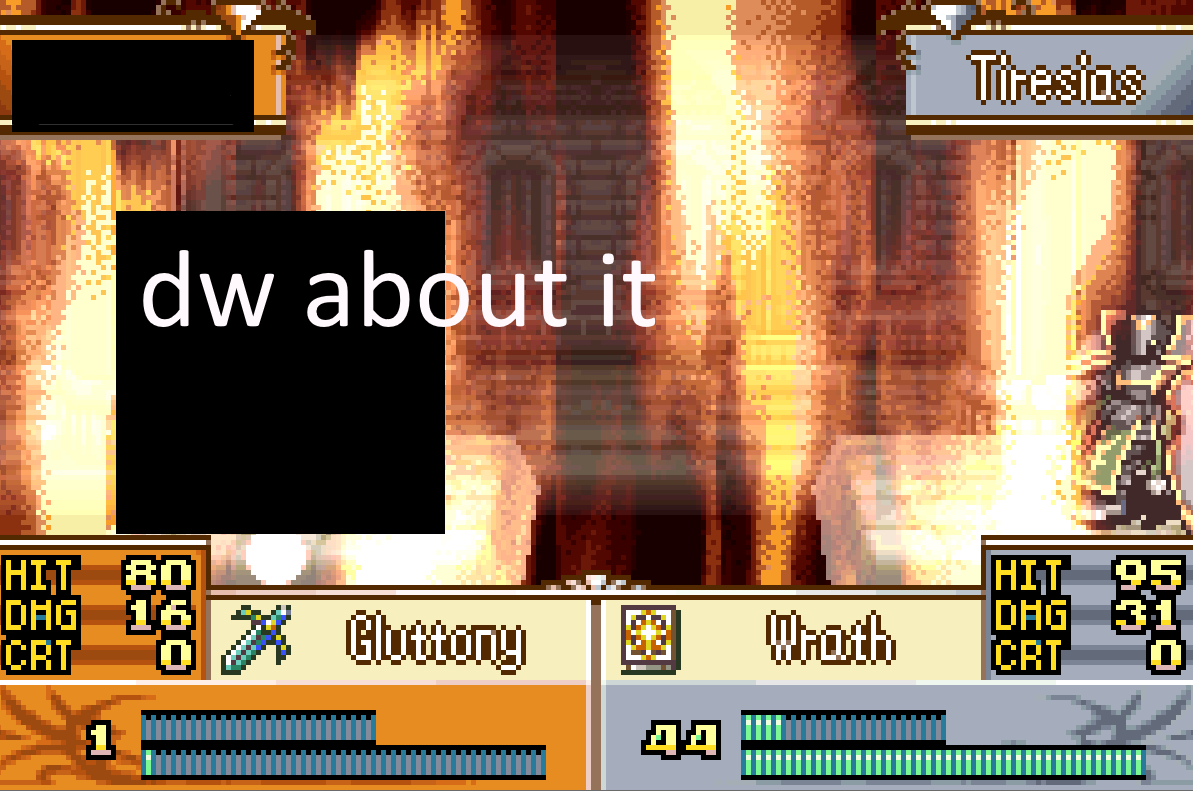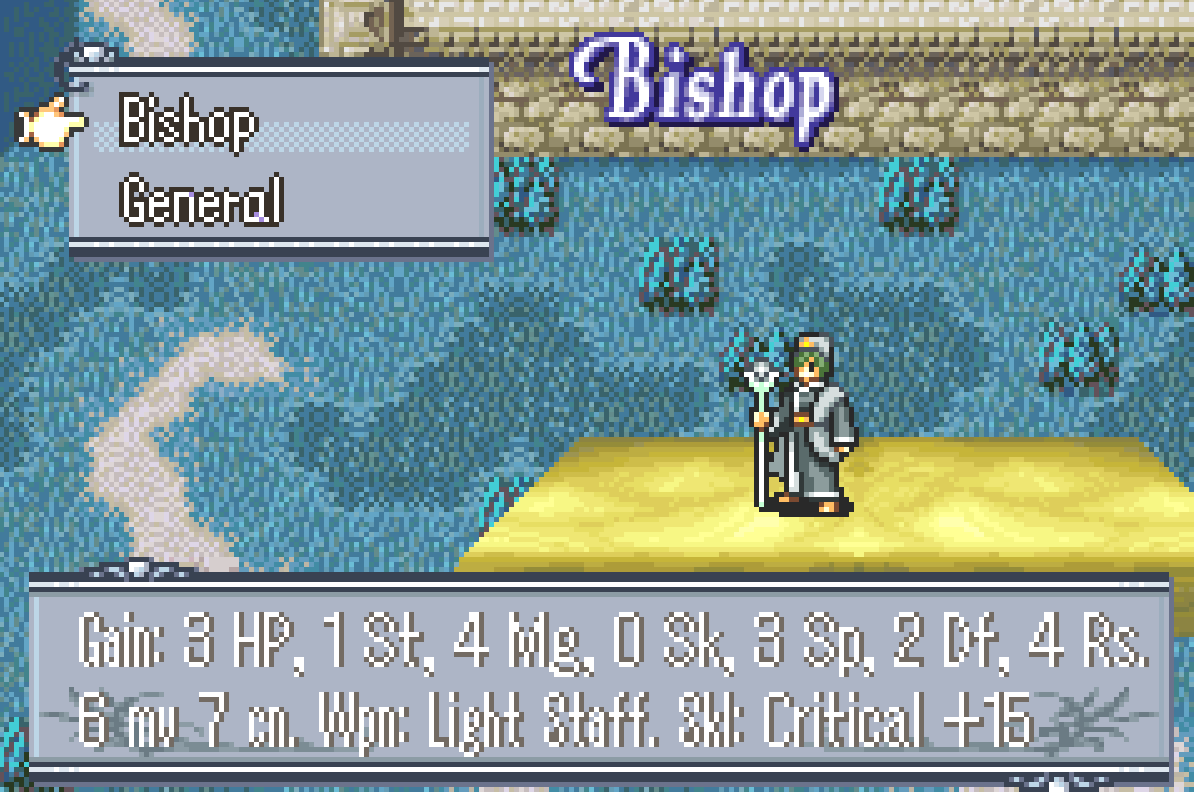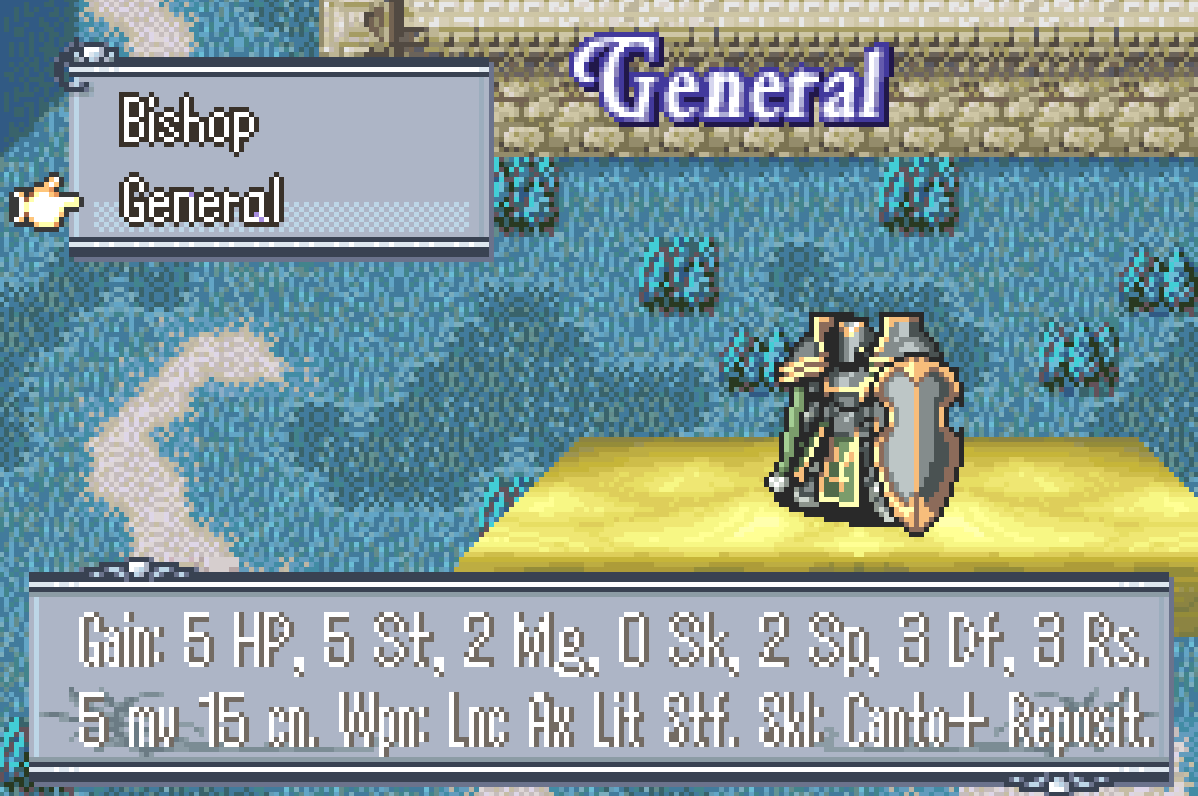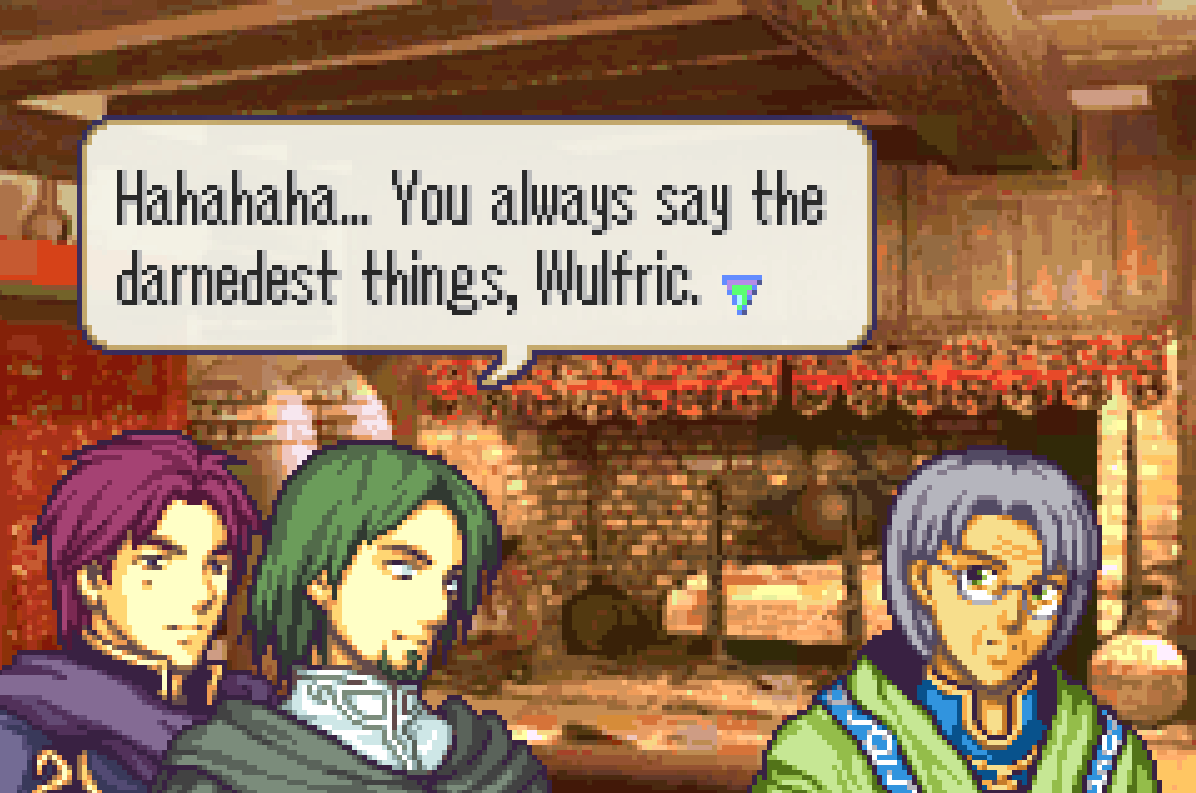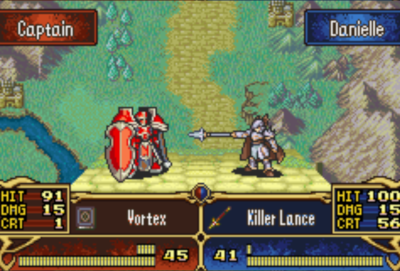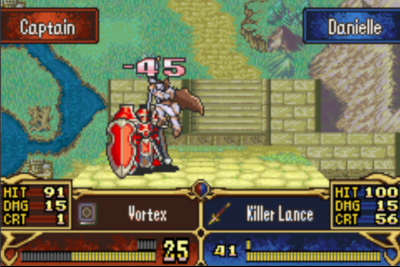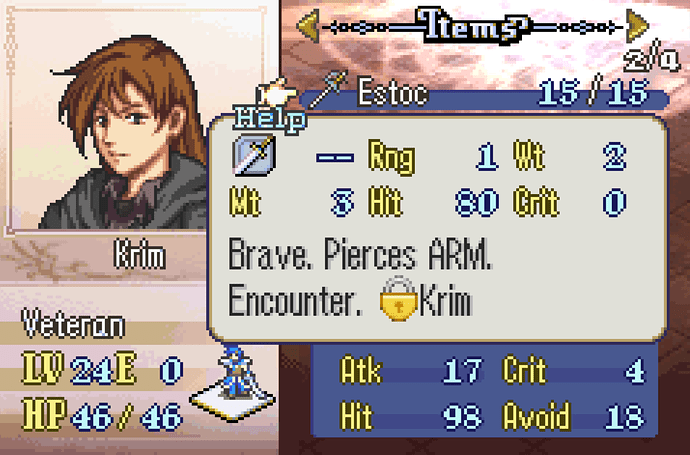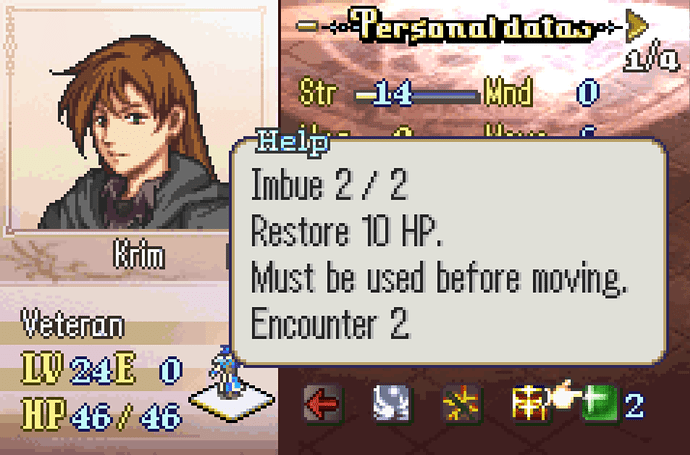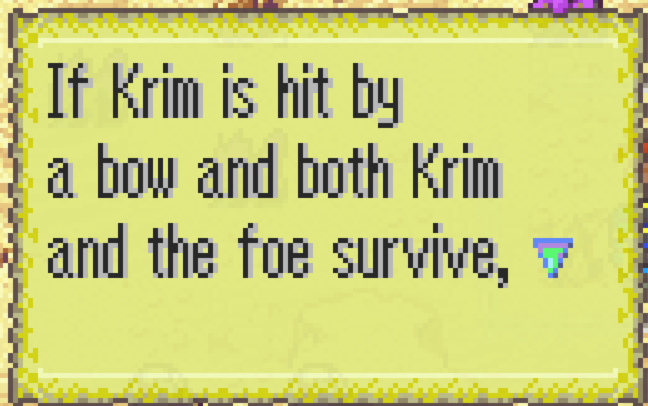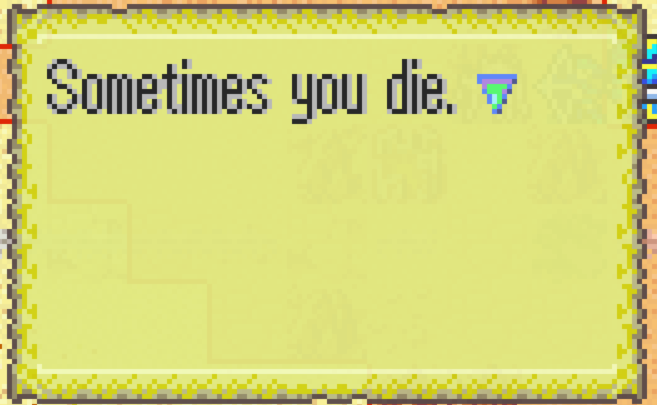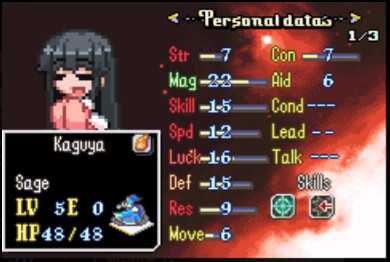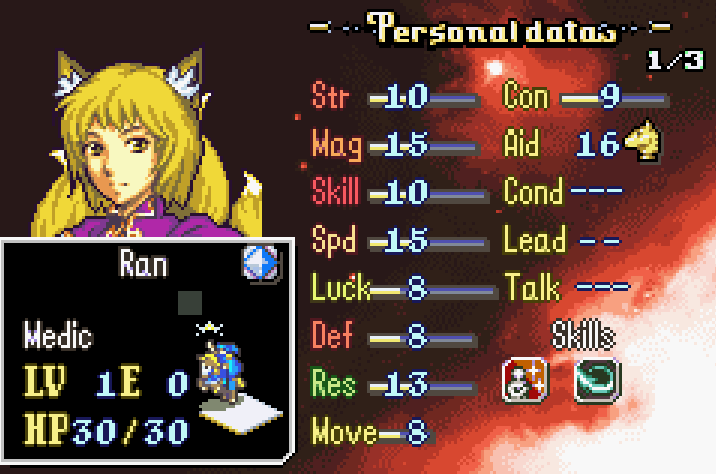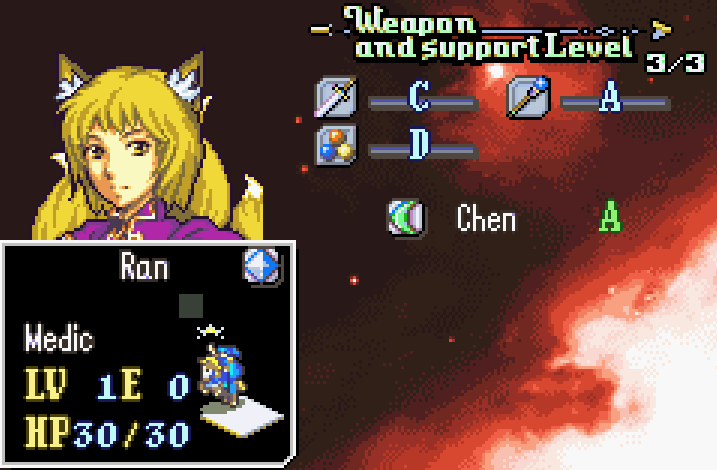With that out of the way, let’s get started.
The effortpost
The unit I’d like to discuss is Donovan from Sun God’s Wrath.
Donovan is a unit with an inherently unique position in the world of hacking. Not just because Sun God’s Wrath is a rather… special hack by most estimations, but because it is a sequel. And because it is a sequel, it can bring back characters from the previous game in the series, should it want to.
Indeed, Sun God’s Wrath does very much want to.
Basically the entire cast is comprised of either characters from the previous game, Corrupt Theocracy (which the hacker himself advises you not to play), or their descendants. This doesn’t really impact enjoyment or comprehension - I was able to play through the entirety of SGW without having played CT before and I didn’t feel like I was missing crucial information. The worldbuilding and story explained most of the things I felt I needed to understand.
What SGW doesn’t tell the players, however, is that Donovan was the protagonist of Corrupt Theocracy. Instead, it builds up his mystique in a variety of different ways.
- He appears in Chapter 3 and absolutely destroys the boss of the map with his special weapon, the Aura Blade.
- He is described as a hero of the World War, the main worldwide conflict that preceded the current one by twenty-five years.
- He allegedly explored the distant lands beyond and only recently returned to the continent.
- He had a child with the current queen of Ryu. You recruit that child – Daedalus – later in the story, and he becomes one of the main characters.
- Some of the primary villains of SGW know him personally, including Mandrake and Larry.
But at the same time, a subplot is introduced. Something seems odd about this new Donovan, and the oddities pile up over time.
- He doesn’t recognize Janet, a woman you recruit who he had an extended romantic relationship with.
- Instead, he wanders around with someone else he calls Janet, who looks similar to the player’s Janet, but isn’t quite the same. He claims to have only ever known that Janet.
- He doesn’t seem to remember certain other individuals he should remember.
The subplot, like many of the game’s other subplots, continues in the background, and you anxiously await its resolution. Eventually, it seems to be resolved… in an unexpected way.
In Chapter 21, you get a scene where Donovan’s Janet is killed by bandits. Ren, a character who you previously used as a powerful temporary unit, is also present. Donovan grieves, but then, Baine shows up. Baine had been an armored knight with a hidden face who periodically showed up to help the player’s army – yet now, he appears in front of Donovan, and he is presented as the leader of the bandits who killed “Janet.”
And the scene progressively becomes more confusing. Donovan attacks Baine as revenge, but his Aura Blade – which you’d always been told is a mighty weapon – passes right through Baine without dealing damage. Ren warns him that he cannot use this weapon against “him,” referring to Baine. But her warning amounts to nothing. Astrea, and the other protagonists, appear just in time to see Donovan slain by Baine, who calls him pathetic as he dies.
Baine then proceeds to accuse Ren of lying about something, and Ren tries to attack him. Based on gameplay experience, you’d expect her to at least make a dent, because she has massive stats while she’s controllable and she basically serves as her map’s delete button. But that doesn’t happen. She deals no damage, and Baine one-shots her in return.
Not only did this Baine just kill the hero Donovan, but he also slew one of the most powerful temporary units in the game in one blow.
But why did he do it, and who is he?
As it turns out, he is the real Donovan, forced to serve Zalmoxis, another of the game’s antagonists. And that is why the Aura Blade had no effect on him. Because it was his weapon to begin with.
And in that moment, you understand that the person you thought was Donovan does not hold a candle to the real thing. That general he one-shot in Chapter 3? That wasn’t Donovan. That was a pretender. The real Donovan wipes the floor with the pretender, one-shots units you thought were excellent, and laughs at them as they die. You also had the opportunity to see Baine on a map several times, helping you under a fake identity, and he is basically invincible on those maps.
But he cannot join you. Because he is trapped. He is doomed to serve Zalmoxis, for reasons I won’t get into in this post. Play SGW. Even in this truncated version, I find myself struggling to properly explain the context of every event.
–
Donovan reappears later, in Chapter 25, which is my favorite map in the game. This time, he appears as himself. Not as Baine. There is no reason to hide anymore.
The premise of the map is that only two of Astrea (the protagonist), Daedalus (a deuteragonist, and Donovan’s son), and Donovan are “needed” by the main villain. One of them needs to die here.
As such, the map only has two deployment slots, both of which are occupied by force-deployed Astrea and Daedalus.
Donovan shows up with a Light Brand. Not the Aura Blade. Not any other strong weapon. A Light Brand.
You probably know where this is going.
When Donovan enters combat with Daedalus, Daedalus cannot take him seriously. He knows Donovan is not trying to win. If he did, Astrea and Daedalus couldn’t stop him.
Daedalus talks to him. Donovan claims he must obey the villain.
Astrea talks to him. They have a brief exchange about the power of gods, and how each god’s power counters the power of a different god. Donovan refuses to say which god’s power counters the power of Zalmoxis, the god whose pawn he became. He implies he cannot.
But Astrea figures it out.
She talks to Daedalus. She has a pendant of Mila. As she remembers, her power should counter the power of Zalmoxis. She just has to put the pendant on him… but the pendant is what keeps her alive, so if she does that, she’ll be risking death.
They go through with the plan anyway.
It works. Barely. Donovan snaps out of Zalmoxis’s control. He quickly gives Astrea her pendant back, before she dies. He then turns to the overseer of this battle, claiming that Zalmoxis no longer has any power over him.
The rest of the map is a formality. The overseer appears to fight, but you wipe the floor with him. You finally get to use Donovan, after all, and… he pulls out the Aura Blade, which he had all along. This just confirms he had no intention of winning while he was still a pawn. But now, he pulls out all the stops.
You can test out his combat against the boss of the map, and it is ridiculous.
And the next chapter is Endgame, which Donovan is available for.
–
Let me get into Donovan as a unit now.
He gained some EXP on the previous map for me.
He has big stats, as you would expect from a Gotoh. And those stats are made even bigger by the Aura Blade, which is his personal weapon.
He is basically impervious to magical attacks. He has permanent, unbreakable 1-2 Range, and his effective 27 Spd is high enough to double basically everything on the map. He hits like a truck, and he even offers two leadership stars.
His skillset is amazing. Renewal and Aether keep him alive without the need for healing and allow him to one-round whatever his natural stats don’t. Nihil prevents him from having to care about the bosses’ skills (and bosses in SGW have many skills). As if 60 effective Res wasn’t overkill enough, he even has Aegis, a Skl% chance to negate an oncoming magical attack - and he effectively has 54 Skl, so those procs will be occurring more often than not. When initiating at 1 Range, he also has +14 Hit/Crit from Arcane Blade, which is just the cherry on top. Of course, he also has an S-rank in swords, and he even has an A-rank in lances, so he doesn’t have to use the Aura Blade - but why wouldn’t he?
Donovan can do basically everything, from baiting enemies without a chance of death to fighting the bosses competently and supporting your army wherever you put him. Most importantly, however, as Donovan himself tells you, his Aura Blade is by far one of the best tools against Zalmoxis, the ultimate final boss. In fact, Donovan is the intended method of beating that boss. He with the Aura Blade deals by far the most damage and is by far the most reliable at killing him. Not using Donovan isn’t a softlock – and in fact, his recruitment is optional, because you can just kill him in Chapter 25 and he’ll be replaced by a different Gotoh – but he sure does make the fight a lot easier, and it’s just narratively poignant for him to kill the god who enslaved him to begin with. Everything comes full circle, in a way. The protagonist of Corrupt Theocracy kills the final boss of the sequel.
The fact Donovan is the best tool against the final boss, and that using him makes you feel very powerful, is reminiscent to the status of Athos from FE7 in my eyes, and that is a good thing. Apart from that, however, I find he’s handled rather competently by the narrative, which is why I had to go over it at least briefly. He’s appropriately built up as a legend, his fake appears early on, then he himself appears in disguise, then once he reveals himself, he quickly makes it known just how powerful he really is. His recruitment is a cool narrative moment in my opinion, and in a way, he brings the two halves of the duology (if you can call it that) together by potentially killing the final boss.
I think Donovan uniquely benefits from SGW being a sequel, even though it’s disconnected enough that someone who hadn’t played CT (like me) can still understand everything. He receives the appropriate buildup the protagonist of the previous game would deserve, and once you do get to use him, it certainly feels like you’re using someone who’s been trained throughout an entire Fire Emblem game before.
Oh, and he has a personal class. This is frankly a footnote, but it aligns him with several other Gotohs in hacks and mainline games, including Athos. And it makes him feel more unique. That always counts.
Play SGW. The hack’s story is wild, but surprisingly coherent by the end, and it has a lot of diverse units. I could easily make some effortposts about its other characters from a gameplay-focused perspective - for example, about Nicole. Maybe that’ll be my next contribution to this thread.
See you next time.
